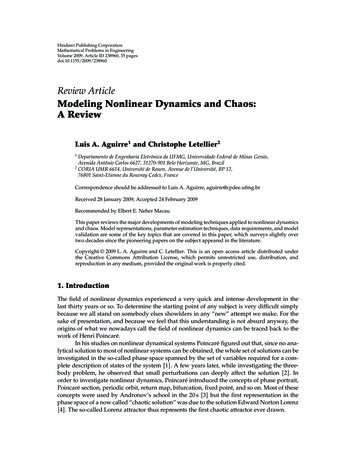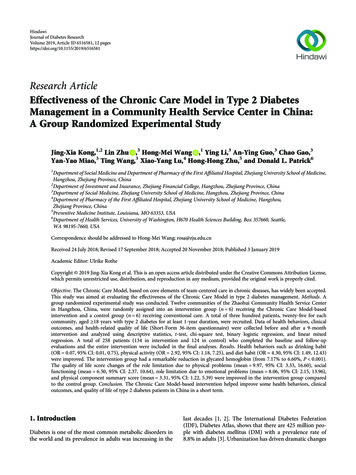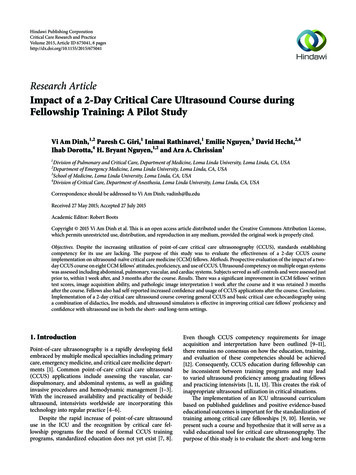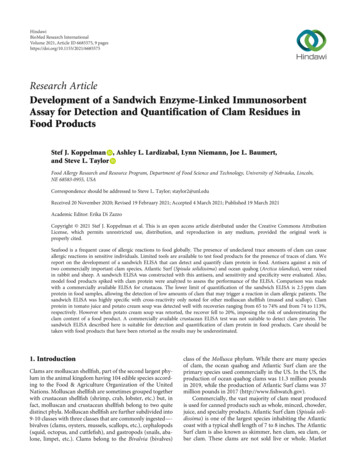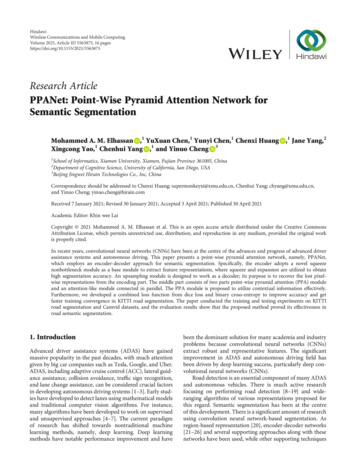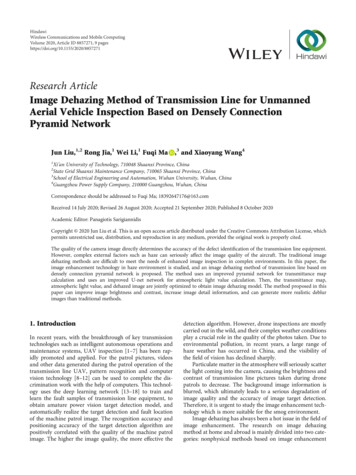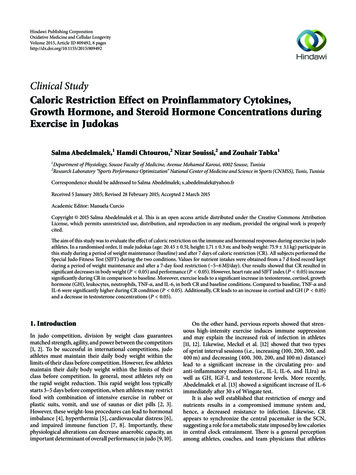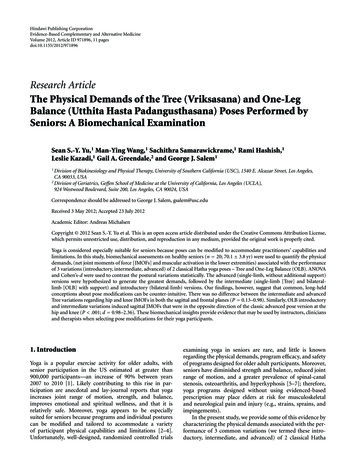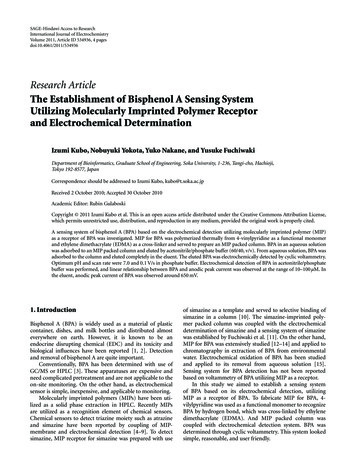
Transcription
SAGE-Hindawi Access to ResearchInternational Journal of ElectrochemistryVolume 2011, Article ID 534936, 4 pagesdoi:10.4061/2011/534936Research ArticleThe Establishment of Bisphenol A Sensing SystemUtilizing Molecularly Imprinted Polymer Receptorand Electrochemical DeterminationIzumi Kubo, Nobuyuki Yokota, Yuko Nakane, and Yusuke FuchiwakiDepartment of Bioinformatics, Graduate School of Engineering, Soka University, 1-236, Tangi-cho, Hachioji,Tokyo 192-8577, JapanCorrespondence should be addressed to Izumi Kubo, kubo@t.soka.ac.jpReceived 2 October 2010; Accepted 30 October 2010Academic Editor: Rubin GulaboskiCopyright 2011 Izumi Kubo et al. This is an open access article distributed under the Creative Commons Attribution License,which permits unrestricted use, distribution, and reproduction in any medium, provided the original work is properly cited.A sensing system of bisphenol A (BPA) based on the electrochemical detection utilizing molecularly imprinted polymer (MIP)as a receptor of BPA was investigated. MIP for BPA was polymerized thermally from 4-vinylpyridine as a functional monomerand ethylene dimethacrylate (EDMA) as a cross-linker and served to prepare an MIP packed column. BPA in an aqueous solutionwas adsorbed to an MIP packed column and eluted by acetonitrile/phosphate buffer (60/40, v/v). From aqueous solution, BPA wasadsorbed to the column and eluted completely in the eluent. The eluted BPA was electrochemically detected by cyclic voltammetry.Optimum pH and scan rate were 7.0 and 0.1 V/s in phosphate buffer. Electrochemical detection of BPA in acetonitrile/phosphatebuffer was performed, and linear relationship between BPA and anodic peak current was observed at the range of 10–100 μM. Inthe eluent, anodic peak current of BPA was observed around 650 mV.1. IntroductionBisphenol A (BPA) is widely used as a material of plasticcontainer, dishes, and milk bottles and distributed almosteverywhere on earth. However, it is known to be anendocrine disrupting chemical (EDC) and its toxicity andbiological influences have been reported [1, 2]. Detectionand removal of bisphenol A are quite important.Conventionally, BPA has been determined with use ofGC/MS or HPLC [3]. These apparatuses are expensive andneed complicated pretreatment and are not applicable to theon-site monitoring. On the other hand, as electrochemicalsensor is simple, inexpensive, and applicable to monitoring.Molecularly imprinted polymers (MIPs) have been utilized as a solid phase extraction in HPLC. Recently MIPsare utilized as a recognition element of chemical sensors.Chemical sensors to detect triazine moiety such as atrazineand simazine have been reported by coupling of MIPmembrane and electrochemical detection [4–9]. To detectsimazine, MIP receptor for simazine was prepared with useof simazine as a template and served to selective binding ofsimazine in a column [10]. The simazine-imprinted polymer packed column was coupled with the electrochemicaldetermination of simazine and a sensing system of simazinewas established by Fuchiwaki et al. [11]. On the other hand,MIP for BPA was extensively studied [12–14] and applied tochromatography in extraction of BPA from environmentalwater. Electrochemical oxidation of BPA has been studiedand applied to its removal from aqueous solution [15].Sensing system for BPA detection has not been reportedbased on voltammetry of BPA utilizing MIP as a receptor.In this study we aimed to establish a sensing systemof BPA based on its electrochemical detection, utilizingMIP as a receptor of BPA. To fabricate MIP for BPA, 4vilylpyridine was used as a functional monomer to recognizeBPA by hydrogen bond, which was cross-linked by ethylenedimethacrylate (EDMA). And MIP packed column wascoupled with electrochemical detection system. BPA wasdetermined through cyclic voltammetry. This system lookedsimple, reasonable, and user friendly.
2International Journal of Electrochemistry2. Experimental2.2. Preparation of Molecularly Imprinted Polymer Receptor forBPA. Molecularly imprinted polymer for BPA was preparedaccording to the procedure reported previously in [13]and modified. 4-vinyl pyridine was used as a functionalmonomer to fabricate the recognition site for BPA bythe hydrogen bonding and cross-liked by EDMA. All thereagents were dissolved by toluene and polymerized at60 C. The obtained polymer was crushed well into particles.The particles were thoroughly washed to remove templatemolecule by methanol and dried in vacuo. In the preparationof MIP, 1 g of MIP was obtained from 90 mg of BPA, 320 mgof 4-vinylpyridine, and 2.5 mL of EDMA. The dried polymerparticles were filtrated and selected, size between 32 and90 μm mesh. These particles were served as MIP receptorfor BPA and 10 mg of them were packed in a glass column.Absorbance of BPA to the MIP receptor was evaluated by theUV absorbance at 270 nm of the loaded and eluted solutionof BPA.Adsorption2.1. Materials. BPA, which is a standard chemical forenvironmental analysis, and 4-vinylpyridine were purchasedfrom Kanto Chemicals. Dibutyl phthalate, 2, 2 -azobis(2, 4dimethylvaleronitril), and Ethylene dimethacrylate (EDMA)were obtained from WAKO Pure Chemicals. Other reagentswere laboratory-grade and used without any purification. 4vinylpiridine was distilled to remove stabilizer prior to use.0.30.20.10250260270280Wavelength (nm)290300Figure 1: Absorbance of bisphenol A to MIP packed column, andelution from the column loading solution of bisphenol A, passed through solution, eluent.CH3HOCOHCH3Bisphenol AHOCH2OHBisphenol FHO2.3. Electrochemical Measurements. A three-electrode cellwas used in the electrochemical measurements. A goldelectrode (I.D. 1.6 mm) was used as a working electrode. A platinum wire counter and an Ag/AgCl referenceelectrode were used in the electrochemical experiments.Electrochemical measurements were carried out in a glassvial containing 1 mL of deoxygenated electrolyte solutionat room temperature according to the previously reportedprocedure [15]. Cyclic voltammetry of BPA was measured ata range from 0 V to 0.8 V. The response to BPA was obtainedfrom the current difference, with and without BPA at around0.6 V, which was the anodic peak current of BPA oxidation.2.4. BPA Sensing System. BPA sensing system was equippedwith an MIP packed column to electrochemical measurement system. An aliquot of sample solution containing BPAwas loaded to the MIP column. The bound BPA was eluted by60% (v/v) acetonitrile/0.1 M phosphate buffer (pH7.0). Theeluent was served to electrochemical measurement.3. Results and Discussion3.1. Selective Adsorption of BPA to MIP. Aqueous BPAsolution (50 μM) was loaded to the column and adsorptionand elution of BPA were examined by UV spectroscopy. Asshown in Figure 1, the loaded BPA was mostly adsorbed tothe column, and in the eluent, bound BPA was removedcompletely. In order to test the selectivity of the column, bisphenol F (BPF) and nonylphenol were examined.NonylphenolFigure 2: Chemical structures of bisphenol A, bisphenol F, andnonylphenol.Table 1: Selectivity of MIP packed column to bisphenol A.Sample Conc. (μM)Adsorption efficiencyElution efficiencyBisphenol A501.00.92Bisphenol F500.800.74Nonylphenol501.00.43The chemical structures of BPA, BPF, and nonylphenol wereshown in Figure 2. Fifty μM of these solutions were loaded tothe MIP column and checked. Table 1 shows the selectivity ofthe adsorption and elution. More than 90% of adsorbed BPAwas eluted; however, adsorption of BPF was smaller than BPAand elution of nonylphenol was less than half of BPA. Amongthem, recovery of BPA from the MIP packed column wasthe largest. It was favorable for the selective determinationof BPA.3.2. Electrochemical Determination of BPA. Experimentalcondition of electrochemical measurement of BPA wasoptimized first. As the condition, pH of the electrolytewas examined at 4.0, 5.8, and 7.0. At higher pH than 7.0electrochemical measurement of BPA was not examined
International Journal of Electrochemistry3.3. Determination of BPA in the Sensing System. As BPAwas electrochemically measured in eluting solution, BPAwas determined, using the system coupled with the MIPcolumn. One ml of sample solution containing 50 μM of BPAwas loaded to the column and the path-thorough solutionand eluent was electrochemically measured. As shown inFigure 6 distinguished peak to passed-through solution wasnot observed; however, in the eluent, anodic peak at around0.6 V was clearly observed, and 10 μM of BPA was detectedtoo. Observed peak current almost agreed with that observedin 60% acetonitrile solution. As for the selectivity in anodicresponse, nonylphenol showed a different response in cyclicvoltammetry. BPA would be easily distinguished from otherphenols except bisphenols.0.2pH 7Current (µA)0.10 0.1With the sensing system composed of the MIP packedcolumn and an electrochemical analyzer, BPA was easily00.20.40.60.8Potential (E/V)Figure 3: Effect of pH to the anodic oxidation of bisphenol A. Cyclicvoltammogram of 0.02 mM bisphenol A. scan rate 0.1 V/sec.3IP (µA)21000.511.5Scan rate (V1/2 /s1/2 )Figure 4: Effect of scan rate to the anodic oxidation of bisphenolA. Anodic peak potentials of 0.1 mM bisphenol A at pH 7.0 wereplotted.10.80.60.40.204. ConclusionpH 5.8pH 4Peak current (µA)because the hydroxyl group of BPA is reported to bepartly dissociated to phenolate ion and oxidation of neutralBPA does not take place. Therefore neutral and acidic pHwas examined. Anodic oxidation of BPA was observed asshown in Figure 3, and anodic peak potentials of pH 4.0,5.8, and 7.0 were 0.695, 0.604, and 0.520 mV, respectively.Peak potentials shifted to lower as to the higher pH.The peak current was the highest at pH 7.0. Thus inthis study, 0.1 M phosphate buffer, pH 7.0, was used. Asfor the mechanism of electrochemical oxidation of BPA,it was known as the generation of the phenoxy radicaland quinone [15].Next, scan rate was examined (Figure 4). Below the scanrate of 0.1 V/sec, peak current showed the linear relationshipto square root of scan rate. On the other hand, linearrelationship was not observed at the scan rate faster than0.1 V/sec. These phenomena suggest that at the faster scanrate, electrochemical reaction is not reversible and the sidereaction occurs coincidently. In the detection of BPA, cyclicvoltammetry was carried out at the scan rate of 0.1 V/sec or0.05 V/sec to avoid side reaction.Under the optimum condition, calibration of BPA wasperformed. In Figure 5 anodic peak current was plottedagainst the concentration of BPA in 0.1 M phosphate buffer,pH 7.0, and 60% (v/v) acetonitrile in phosphate buffer(eluting solution). Linear relationship (y 8.8843x) wasobserved between 10 μM to 100 μM of BPA in phosphatebuffer pH 7.0. In the eluting solution (60% of acetonitrile),linear relationship (y 6.836x 0.149) was observed atalmost the same range of concentration, although the slopewas slightly smaller than in phosphate buffer. In elutingsolution, at lower concentration than 0.02 mM, larger peakcurrent was observed than in phosphate buffer. Electrolytein acetonitrile worked to help the electrochemical oxidationespecially at lower concentration. Then the apparent intercept of the calibration line of BPA in acetonitrile was largerthan in phosphate buffer.300.040.080.12BPA concentration (mM)Figure 5: Calibration plot of bisphenol A. in 0.1 M phosphatebuffer, pH 7.0, in 60% (v/v) acetonitrile/0.1 M phosphate buffer,pH7.0. Scan rate 0.1 V/sec.
4International Journal of Electrochemistry0.75Eluent[7]Current (µA)0.5[8]0.250[9]Passedthroughsolution 0.25 0.500.20.40.6[10]0.8Potential (V)[11]Figure 6: Response of bisphenol A with this sensing system.determined at the range of 10–100 μM of BPA rapidly. Thissystem will be applied to the determination of food orbiological fluid in the near future.[12][13]AcknowledgmentsThis work was supported by a Grant-in-Aids for scientificresearch from the Ministry of Education, Science, Sports andCulture, Japan. The authors are grateful for helpful supportfrom Dr. Kanamatsu in Soka University.[14][15]References[1] J. E. Biles, K. D. White, T. P. McNeal, and T. H. Begley,“Determination of the diglycidyl ether of bisphenol A and itsderivatives in canned foods,” Journal of Agricultural and FoodChemistry, vol. 47, no. 5, pp. 1965–1969, 1999.[2] R. Pulgar, M. F. Olea-Serrano, A. Novillo-Fertrell et al., “Determination of bisphenol A and related aromatic compoundsreleased from Bis-GMA-based composites and sealants byhigh performance liquid chromatography,” EnvironmentalHealth Perspectives, vol. 108, no. 1, pp. 21–27, 2000.[3] J. Sajiki, K. Takahashi, and J. Yonekubo, “Sensitive methodfor the determination of bisphenol-A in serum using twosystems of high-performance liquid chromatography,” Journalof Chromatography B, vol. 736, no. 1-2, pp. 255–261, 1999.[4] M. T. Muldoon and L. H. Stanker, “Polymer synthesis andcharacterization of a molecularly imprinted sorbent assay foratrazine,” Journal of Agricultural and Food Chemistry, vol. 43,no. 6, pp. 1424–1427, 1995.[5] J. Matsui, Y. Miyoshi, O. Doblhoff-Dier, and T. Takeuchi,“A molecularly imprinted synthetic polymer receptor selective for atrazine,” Analytical Chemistry, vol. 67, no. 23,pp. 4404–4408, 1995.[6] T. A. Sergeyeva, S. A. Piletsky, A. A. Brovko, E. A. Slinchenko,L. M. Sergeeva, and A. V. El’skaya, “Selective recognition of atrazine by molecularly imprinted polymer membranes. Development of conductometric sensor for herbicidesdetection,” Analytica Chimica Acta, vol. 392, no. 2-3, pp. 105–111, 1999.C. Luo, M. Liu, Y. Mo, J. Qu, and Y. Feng, “Thickness-shearmode acoustic sensor for atrazine using molecularly imprintedpolymer as recognition element,” Analytica Chimica Acta, vol.428, no. 1, pp. 143–148, 2001.T. Panasyuk-Delaney, V. M. Mirsky, M. Ulbricht, and O. S.Wolfbeis, “Impedometric herbicide chemosensors based onmolecularly imprinted polymers,” Analytica Chimica Acta, vol.435, no. 1, pp. 157–162, 2001.R. Shoji, T. Takeuchi, and I. Kubo, “Atrazine sensor basedon molecularly imprinted polymer-modified gold electrode,”Analytical Chemistry, vol. 75, no. 18, pp. 4882–4886, 2003.Y. Fuchiwaki, A. Shimizu, and I. Kubo, “6-Chloro-N,Ndiethyl-1,3,5-triazine-2,4-diamine (CAT) sensor based onbiomimetic recognition utilizing a molecularly imprintedartificial receptor,” Analytical Sciences, vol. 23, no. 1, pp. 49–53, 2007.Y. Fuchiwaki, N. Sasaki, and I. Kubo, “Development ofan electrochemical sensing system for 6-chloro-n,n-diethyl1,3,5-triazine-2,4-diamine (CAT) utilizing an amalgamatedgold electrode and artificial sensor receptor,” Electrochemistry,vol. 75, no. 9, pp. 709–714, 2007.V. P. Joshi, M. G. Kulkarni, and R. A. Mashelkar, “Molecularlyimprinted adsorbents for positional isomer separation,” Journal of Chromatography A, vol. 849, no. 2, pp. 319–330, 1999.H. Sanbe and J. Haginaka, “Uniformly sized molecularlyimprinted polymers for bisphenol A and β-estradiol: retentionand molecular recognition properties in hydro-organic mobilephases,” Journal of Pharmaceutical and Biomedical Analysis,vol. 30, no. 6, pp. 1835–1844, 2003.T. Kubo, K. Hosoya, Y. Watabe et al., “On-column concentration of bisphenol A with one-step removal of humic acidsin water,” Journal of Chromatography A, vol. 987, no. 1-2, pp.389–394, 2003.H. Kuramitz, Y. Nakata, M. Kawasaki, and S. Tanaka, “Electrochemical oxidation of bisphenol A. Application to the removalof bisphenol A using a carbon fiber electrode,” Chemosphere,vol. 45, no. 1, pp. 37–43, 2001.
International Journal ofMedicinal ChemistryHindawi Publishing Corporationhttp://www.hindawi.comVolume 2014PhotoenergyInternational Journal ofOrganic ChemistryInternationalHindawi Publishing Corporationhttp://www.hindawi.comVolume 2014Hindawi Publishing Corporationhttp://www.hindawi.comVolume 2014International Journal ofAnalytical ChemistryHindawi Publishing Corporationhttp://www.hindawi.comVolume 2014Advances inPhysical ChemistryHindawi Publishing Corporationhttp://www.hindawi.comVolume 2014International Journal ofCarbohydrateChemistryHindawi Publishing Corporationhttp://www.hindawi.comJournal ofQuantum ChemistryHindawi Publishing Corporationhttp://www.hindawi.comVolume 2014Volume 2014Submit your manuscripts athttp://www.hindawi.comJournal ofThe ScientificWorld JournalHindawi Publishing Corporationhttp://www.hindawi.comJournal ofInternational Journal ofInorganic ChemistryVolume 2014Journal ofTheoretical ChemistryHindawi Publishing Corporationhttp://www.hindawi.comHindawi Publishing Corporationhttp://www.hindawi.comVolume 2014SpectroscopyHindawi Publishing Corporationhttp://www.hindawi.comAnalytical Methodsin ChemistryVolume 2014Hindawi Publishing Corporationhttp://www.hindawi.comVolume 2014ChromatographyResearch InternationalHindawi Publishing Corporationhttp://www.hindawi.comVolume 2014International Journal ofElectrochemistryHindawi Publishing Corporationhttp://www.hindawi.comVolume 2014Journal ofHindawi Publishing Corporationhttp://www.hindawi.comVolume 2014Journal ofCatalystsHindawi Publishing Corporationhttp://www.hindawi.comJournal ofApplied ChemistryHindawi Publishing Corporationhttp://www.hindawi.comBioinorganic Chemistryand ApplicationsHindawi Publishing Corporationhttp://www.hindawi.comVolume 2014International Journal ofChemistryVolume 2014Volume 2014SpectroscopyVolume 2014Hindawi Publishing Corporationhttp://www.hindawi.comVolume 2014
of MIP, 1g of MIP was obtained from 90mg of BPA, 320mg of4-vinylpyridine, and2.5mL ofEDMA.Thedriedpolymer particles were filtrated and selected, size between 32 and 90μm mesh. These particles were served as MIP receptor for BPA and 10mg of them were packed in a glass column. AbsorbanceofBPAto theMIP receptorwas evaluatedby the

